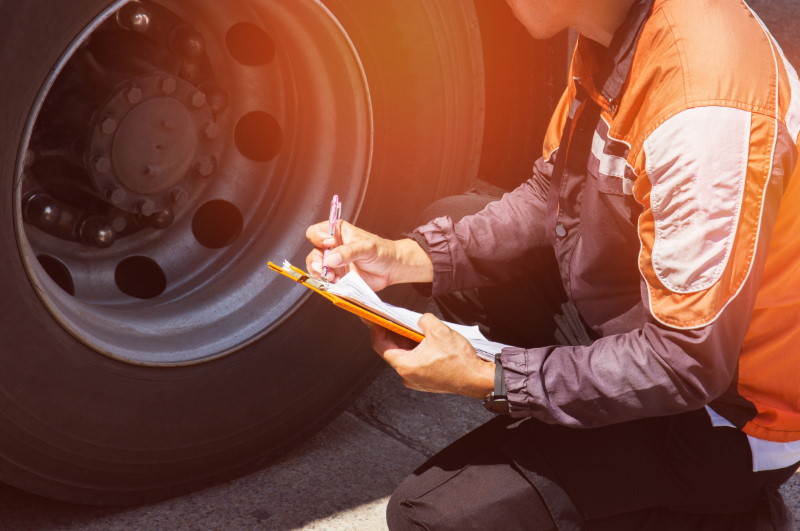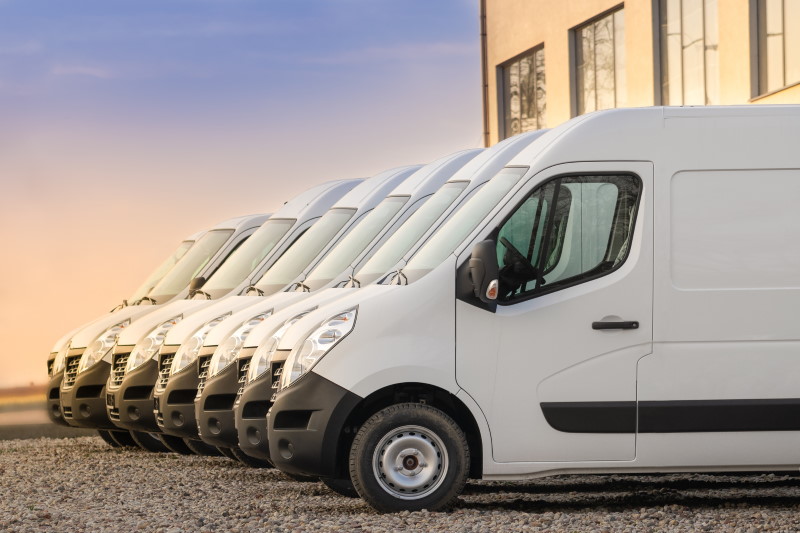
Discover the key to slashing costly vehicle downtime, lengthening the lifespan of your fleet and increasing driver safety: a comprehensive commercial vehicle maintenance checklist.
This checklist will help ensure your operators are prioritizing safety and planning ahead, effectively reducing breakdowns that cost you both time and money.
Find out what your commerical vehicle maintenance checklist should include in our guide below, plus learn how to build your own digital checklist with doForms.
Digitize your checklists.
Try doForms for free!
Table of Contents
What Is A Commercial Vehicle Maintenance Checklist?
A commercial vehicle maintenance checklist is a paper-based or electronic form that consists of items that truck drivers, mechanics and other relevant parties must inspect in order to ensure the reliable functioning of a commercial vehicle.
Commercial vehicle maintenance checklists vary slightly depending on the particular vehicle, whether a delivery van, a semi-truck, a passenger bus or a construction vehicle, and the specific usage.
These checklists allow transport businesses and fleet managers to schedule maintenance and repairs before the vehicle(s) leave for transportation duties and, in doing so, avoid breakdowns.
They also help ensure that operators and drivers are prioritizing driver safety and increasing the lifespan of the vehicle through preventative maintenance care.
Types of Commercial Vehicle Maintenance Checklists
If your business relies on operating commercial vehicles with uninterrupted transportation, commercial vehicle maintenance checklists are vital to reduce costly downtime.
1. Preventive Maintenance Checklist
The aim of a preventative program is to identify potential problems before they arise and put actionable measures in place to prevent them.
A preventive maintenance checklist should include the manufacturer’s recommendations on vehicle maintenance and the approximate time when a vehicle should be serviced.
The rest of the truck maintenance checklist will differ depending on the type of vehicle and its specifications.
Some of the typical items on preventive maintenance checklist include:
- Change the oil
- Change the filter
- Tighten components
- Tune the engine
- Check the brakes
- Rotate the tires
- Check lubrication
- Check the radiator
2. Demand Maintenance Checklist
Demand maintenance is performed only when the need arises.
This means replacing or fixing certain truck parts only when they break down. Demand maintenance can also occur after an independent inspection that determines wear and tear that needs to be addressed on a truck.
Demand maintenance checklists usually include items such as:
- Replace light bulbs
- Replace springs
- Retune gauges
- Replace windows
- Replace seat cushions
- Check engine and transmission
- Replace batteries
- Replace corroded or deteriorated structures
3. Crisis Maintenance Checklist
When preventative and demand maintenance are neglected, a crisis occurs.
Crisis maintenance is performed when a truck breaks down due to sudden failure, resulting in the need for a replacement vehicle to continue operation.
A crisis maintenance checklist will focus on identifying and addressing urgent and critical maintenance tasks required during a crisis situation, such as immediate repairs to ensure safety, restoring essential functionalities and reducing the risk of further damage.
The items to check will depend on the nature of the crisis and the component of the vehicle or equipment that is affected.
Crisis maintenance incurs additional costs, including:
- The time needed to organize repairs and reroute deliveries
- Driver downtime
- The help of an outside mechanic if needed
- The purchase cost of new parts
4. Maintenance Record Checklist
A maintenance record checklist is typically used during routine maintenance or inspections to make sure that all necessary maintenance tasks are completed and documented.
Maintenance checklists verify that schedules were followed, record the details of maintenance performed and list outstanding or upcoming maintenance needs.
Keeping these detailed maintenance records:
- Provides a historical reference of maintenance activities, allowing you to track and analyze specific patterns and recurring issues
- Helps ensure compliance with safety regulations and manufacturer recommendations
- Helps maintain a well-documented maintenance history of your commercial vehicles, which can be useful for warranty claims, identifying resale value and performing audits
Full Truck Maintenance Checklist: 40+ Form Must-Haves
Scheduled and preventative maintenance can reduce the occurrence of breakdowns, which minimizes downtime and revenue loss.
The use of checklist ensures that every part of the vehicle is properly inspected, to increase driver safety.
A truck maintenance checklist should include an inspection of the following parts:
1. Main Technical Inspection
- Engine
- Transmission
- Filters
- Fuel level
- Suspension system
- Steering system
- Belts and hoses
- Auxiliary systems
- Clutch
- Electrical system components
- Exhaust system
2. Fluid & Oil Inspection
- Power steering fluid
- Brake fluid
- Wiper fluid
- Transmission fluid
- Engine and brake oils
- Defrosting system
3. Brake Inspection
- Brake system
- Brake pads
- Emergency brake
4. Light Inspection
- Taillights and brake lights
- High and low beams
- Turn signals
- Reverse lights
- Emergency flashers
- License plate illumination
5. Wheel & Rim Inspection
- Wheel alignment
- Tire conditions
- Spare tires
- Tools for a tire change
6. Interior Inspection
- Air conditioning system
- Horn
- Seat belts
- Gauges
- Fan
- First aid kit
7. Windshield, Back Windows & Mirror Inspection
- Integrity of glass
- Window control system
- Wiper system
- Driver and passenger side mirrors
- Inside mirrors
A truck maintenance checklist should also include the recommended time between servicing and the next inspection.

Commercial vehicle maintenance forms’ must-have elements help mechanics stay on top of things at all times
Benefits Of Preventive Vehicle Maintenance Checklists
Regular and preventative commercial vehicle servicing is crucial for ensuring that the transportation of goods, products and services goes as planned.
As per the Federal Motor Carrier Safety Administration, commercial motor vehicles are prohibited to operate if their condition could cause a breakdown or an accident.
A checklist helps ensure that every part of a commercial vehicle is inspected properly and a detailed record of each inspection is kept.
The benefits of preventive maintenance servicing include:
- Reduced maintenance and repair costs
- Reduced operating costs due to fewer breakdowns
- Reduced insurance costs
- Increased vehicle residual value
- Extended vehicle’s lifespan
- Protection of company assets
- Improved vehicle fuel consumption and reduced of fuel cost
- Reduced of vehicle downtime
- Increased customer or client satisfaction due to on-time deliveries
- Increased driver safety
- Improved working environment for drivers
- Greater passenger safety
- Greater road safety

Truck maintenance checklists help your business keep its fleet in top-notch condition
How to Create an Electronic Commercial Vehicle Maintenance Checklist With doForms
A mobile form solution, doForms allows you to collect and store data in a secure location, create custom checklists and reports and much more.
Our mobile forms collect data on smartphones or tablets, with or without internet, so you can edit forms, manage employee data and more in the office or on the go.
With doForms, you can create unique commercial vehicle maintenance checklists to accommodate any number of vehicles or drivers. Our forms include an electronic signature capture feature and the ability to upload and attach photos or videos.
The data captured with doForms can be synced with other software, giving you everything you need in one centralized database.
Simply choose a template from our vast form library or start your own custom form with our user-friendly interface and convenient drag and drop features.
Once your form or checklist is ready, save it in a secure location and send it out to drivers or mechanics to fill out as needed.
Ready to create a commercial vehicle maintenance checklist?
Try doForms for free!
For Commercial Vehicle Maintenance Checklists
Although you will need to customize your checklists to meet the specific needs and requirements of your commercial vehicles, based on their make, model, usage patterns and industry-specific regulations, here are some tips that can help you create an efficient checklist:
- Review the manufacturer’s maintenance recommendations and guidelines for each vehicle’s make and model. Follow the suggested maintenance intervals and procedures to ensure optimal performance.
- Create pre-trip inspection checklists to identify potential issues before sending your driver out. Check key components such as the engine, tires, brakes, lights, fluids and filters to ensure they are in good working condition and minimize the risk of incidents.
- Check for compliance with relevant regulations, including emission standards and safety requirements.
- Educate your drivers about the importance of routine maintenance and encourage them to report any vehicle issues promptly to foster a culture of responsibility and accountability.
Takeaways On Commercial Vehicle Maintenance Checklists
Commercial vehicle maintenance checklists help companies keep their fleet of vehicles in optimal condition, safe and reliable for the transport of goods and services to retailers and consumers.
There are three main types of vehicle maintenance checklists:
- Preventive maintenance checklist
- Demand maintenance checklist
- Crisis maintenance checklist
Using commercial vehicle maintenance checklists allow you to:
- Reduce operational, insurance and maintenance costs
- Prevent accidents and breakdowns
- Extend vehicle lifespan
- Increase customer or client satisfaction
- Increase driver safety and general road safety
- Improve driver working environment
- Comply with standards required by the law
By swapping out your paper-based checklists for digital checklists with doForms, you can save money, get organized and prioritize the safety and health of both your drivers and your fleet.
doForms allows you to create custom checklists, reports and other forms, collect data and store everything you need in one secure, centralized location, where you can access it with or without internet, in the office or on the go.




